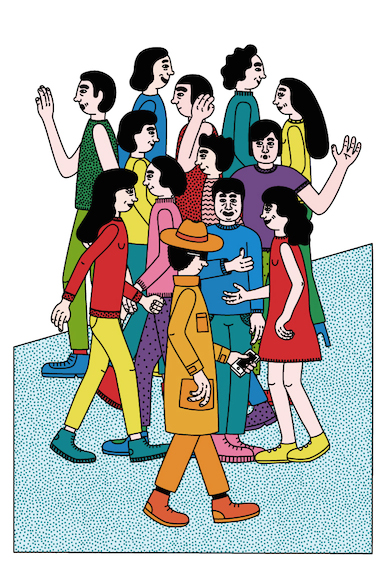Anti-Social Behaviour
Social media's great for keeping in touch with people, but can it also be used to help you keep out of touch?

It’s a familiar situation: it’s Sunday and you’re hung-over. You decide to alleviate the pain with a pack of Wotsits from the local shop, but when you leave the house, greasy haired and wearing a pair of dodgy tracksuit bottoms, you run into someone you don’t want to. They’re probably a boring work colleague, an ex, or most likely, someone you’re friends with on Facebook but don’t quite remember why. You exchange some perfunctory, stilted chat. It’s all very awkward. You sidestep the conversation as soon as you can and make a quick exit.
This sort of encounter is set to become all the more common with the launch of new social media that aims to tell your “friends” where you are. The biggest, Facebook’s forthcoming Nearby Friends service, uses GPS and mobile phone signals to triangulate your position and then broadcast it to your online contacts. You’ll be notified when friends are in your vicinity, all with the aim, explains Facebook, of helping you get in touch and meet up. It’s not just Facebook.
Other social media, such as location-based network Foursquare, have been encouraging us to broadcast our locations and increase our real-world interactions for years. And thanks to our share-everything culture, a quick glance at our social network feed can tell us if anyone is hanging out nearby from a GPS-tagged Instagram post or detailed Facebook status.
The rationale for getting offline can cause problems – if you're the only one in your social environment who has gone offline then it’s difficult to create workarounds for keeping informed of friends’ activities or for being involved in discussions. At times it’s natural to feel the need to get away from our peers – to go off the grid, to delete all our accounts and escape from everyone.
No one can find us when we’re offline and safely locked indoors, right? But while switching off may be tempting, it’s not always that easy to get rid of our social media presence. “I think some people are getting tired of using social media such as Facebook – however, only a few will actually stop,” says Christian Maier, a researcher at the University of Bamberg in Germany who has studied the negative effects of social media usage.
“The rationale for getting offline can cause problems – if you're the only one in your social environment who has gone offline then it’s difficult to create workarounds for keeping informed of friends’ activities or for being involved in discussions.”
So if we can’t quite manage to shut down our social profiles, how can we manage this real-world social network problem? A slew of new projects is offering a solution. The aptly named platform Hell is Other People was created by developer Scott Garner and lets users plug in their social media information to generate a GPS map of their contacts’ whereabouts – not in order to track them down and hang out with them, but to avoid them.
“I created the project as an experiment in antisocial media,” he explains. “I liked the ambiguity of the term because it could mean media for antisocial people, or an attack on social media itself.” I realised then that social media could be used as a real-time source to track illness. While Hell is Other People was developed as a commentary about our digitally over-saturated lives, other recent apps provide a functional escape when we’re feeling a little antisocial.
Cloak, a similarly irreverent app, combs Facebook and Foursquare data to provide a map of the whereabouts of the user’s contacts to help avoid them. Users can even flag a specific individual – that ex you’d rather not bump into – and the map creates a route around them to avoid any chance of an unwanted encounter. It has already received over 300,000 downloads.
Of course, it’s already possible to use social media for these purposes. You could easily avoid someone when Foursquare tells you where they are. But apps such as Cloak bring antisocial needs to the fore. “We think it’s important that someone can go off the grid every now and again if they wish,” explains Chris Baker, founder of Cloak. “Maybe you’re on a first date and want privacy. Maybe you’ve had a nose job and don’t want to see anyone. Or maybe you want to head out with no make-up on. We need that escape and privacy from time to time.”
It’s certainly true that our online social media profiles don’t allow for much privacy or escapism. We tend to vamp up our sociability online. But this is not a true reflection of real-world behaviour – after all, we need our own space and the opportunity to be antisocial every so often.
“People are beginning to understand that even in our socially flooded world, there can be a time when we want to be alone, and be socially selective,” says Udi Dagan, founder of Split, an app which offers a similar service to Cloak. It works by combining Facebook, Foursquare, Twitter and Instagram data to provide a comprehensive digital snapshot of peers’ movements, allowing its users to easily avoid one another, and has already raised over $1m in funding.
While apps such as Cloak and Split help users to avoid socially awkward situations, other apps let people avoid others for more serious reasons. Sickweather, for example, is an app that uses social media data to create a digital map of illnesses within a city, allowing its users to circumnavigate “sick zones” in order to stay healthy.
“I was sick with a stomach virus and wanted to see if it was food poisoning, so checked Facebook and, sure enough, I found a friend complaining of the same symptoms,” says founder Graham Dodge. “I realised then that social media could be used as a real-time source to track illness.” The app analyses social media posts that mention certain keywords related to certain illnesses. So far it has identified outbreaks of flu and whooping cough several weeks before they have been reported by the US Centers for Disease Control and Prevention or by the national media.
With Sickweather, the data gathered from public social media posts remains anonymous, bar the location referenced, so the individuals behind the reports can’t be identified. “Just as some social situations demand privacy, there are some social media channels that should allow privacy when we want it,” says Dodge. “Social doesn’t always mean public.”
And he’s right. Why can’t social media’s function change for different purposes, allowing connectivity one minute, and then privacy the next? Perhaps in the future we’ll see more apps that better mimic our complex real world behaviours – we’re not always in a sociable mood, and our social media should allow for that.
Originally printed in Protein Journal #13. Illustrations by Martina Paukova.


